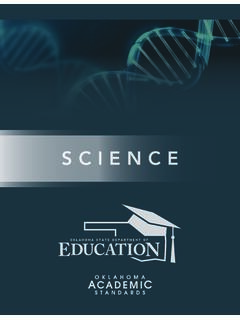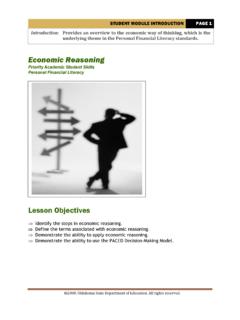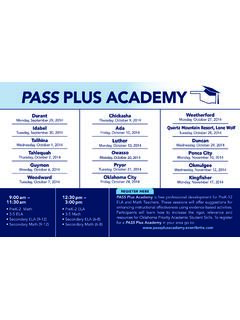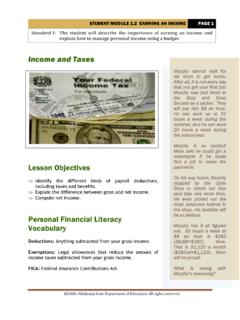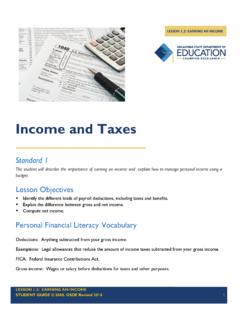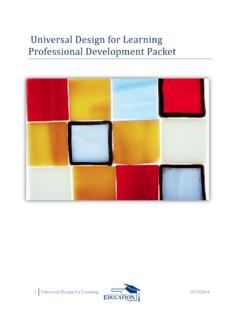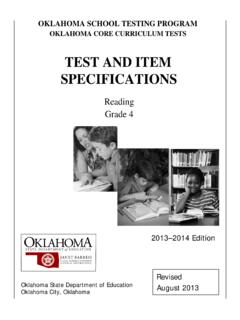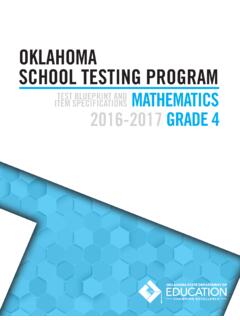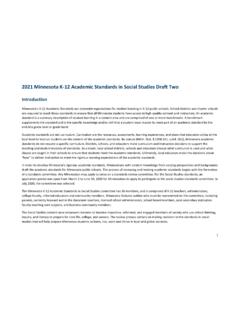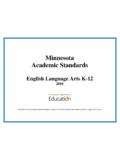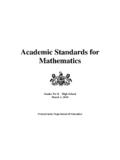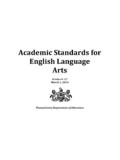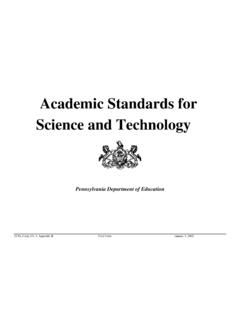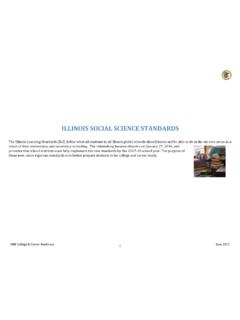Transcription of Oklahoma Academic Standards for Science
1 Oklahoma Academic Standards for Science Introduction February 2020 2 Table of Contents Introduction 3 Grade 8 74 Prekindergarten 9 Physical Science 86 Kindergarten 10 Chemistry 98 Grade 1 15 Physics 110 Grade 2 21 Biology 124 Grade 3 26 Earth and Space Science 143 Grade 4 34 Environmental Science 154 Grade 5 42 Grade 6 50 Grade 7 63 Oklahoma Academic Standards Science Introduction February 2020 3 Introduction The Oklahoma Academic Standards for Science are the result of the contributions of hundreds of Science educators, representatives of higher education, and community members. This document reflects the collaborative work of all members of the Oklahoma Academic Standards for Science Writing and Draft Committees. The Standards specify what students should know and be able to do as learners of Science at the end of each grade level or Science course. The order of the Standards at any grade level is not meant to imply a sequence of topics and should be considered flexible for the organization of any course.
2 The Oklahoma Academic Standards describe the specific areas of student learning that are considered the most important for proficiency in the discipline at a particular level and provide a basis for the development of local curricula and statewide assessments. The Standards are not a curriculum and they do not represent a scope, sequence, or curriculum guide. They provide a framework for schools and teachers to develop an aligned Science curriculum. They are also designed as coherent progressions of learning in grades PreK-12, intended to be used as a whole, ensuring all students are provided opportunities to experience Science at each grade K-8 and various courses at high school. Although instruction may go beyond Standards , using only a portion of the Standards will leave gaps in the scientific understanding and practices of students. The Oklahoma Academic Standards for Science were informed by the 2014 Oklahoma Academic Standards for Science , The Framework for K-12 Science Education (National Academies of Science , 2010), the Next Generation Science Standards (Achieve, Inc.)
3 , 2012), and other states Standards documents. Science is a way of knowing, a process of using observations and investigations to gain knowledge and understanding of the physical and natural world. The PreK-12 Oklahoma Academic Standards for Science place an emphasis on students being active learners. They showcase that it is not enough for students to read about Science ; they must do Science . Students must engage in planning and carrying out investigations, making observations, asking questions, analyzing data, constructing explanations, engaging in argument from evidence, and obtaining, evaluating, and communicating information to gain the Science knowledge and skills to be college, career, and citizen ready upon graduation from high school. Oklahoma Academic Standards Science Introduction February 2020 4 Science Strands Overview The Oklahoma Academic Standards for Science , K-12 are three-dimensional performance expectations representing the things students should know, understand, and be able to do to be proficient in Science and engineering.
4 Performance expectations are considered Standards and include a Science and engineering practice (everyday skills of scientists and engineers), disciplinary core ideas ( Science ideas used by scientists and engineers), and crosscutting concepts (ways of thinking like scientists and engineers). The PreK Standards emphasize one dimension; the Science and engineering practices. This provides early learners with ample time for exploratory play and background experiences that will inform learning experiences K-12. Performance Expectation: Each Performance Expectation is built upon recommendations in A Framework for K-12 Science Education and the three dimensions of Science . 1. Science and Engineering Practices 2. Disciplinary Core Ideas 3. Crosscutting Concepts (NRC, 2012, p. 2) The following additional components in the standard documents serve as support for instructors in providing clarity and further guidance for each Performance Expectation.
5 Clarification Statement: Where needed, a Clarification Statement accompanies a Performance Expectation. The aim of a Clarification Statement is to provide further explanation or examples to better support educators in understanding the aim of the Performance Expectation. Assessment Boundary: Where applicable, an Assessment Boundary accompanies a Performance Expectation in order to provide additional support for educators in understanding the intent of the Performance Expectation and its relation to other Performance Expectations in the learning progression. Teachers should utilize the Assessment Boundaries as tools for developing curriculum and local assessments. For 5th grade, 8th grade, Biology, and Physical Science (s) the Assessement Boundaries will be utilized to inform the development of the state summative Academic achievement assessments. Oklahoma Academic Standards Science Introduction February 2020 5 Dimension 1: Science and Engineering Practices The Science and Engineering Practices describe the major practices that scientists employ as they investigate and build models and theories about the world, and a key set of engineering practices that engineers use as they design and build systems.
6 Performance Expectations that emphasize engineering are designated with an asterik *. The eight Science and engineering practices are: Asking Questions and Defining Problems A practice of Science is to ask and refine questions that lead to descriptions and explanations of how the natural and designed world(s) works. Engineering questions clarify problems to determine criteria for successful solutions. Developing and Using Models A practice of both Science and engineering is to use and construct models as helpful tools for representing ideas and explanations. These tools include diagrams, drawings, physical replicas, mathematical representations, analogies, and computer simulations. Planning and Carrying Out Investigations Scientists and engineers plan and carry out investigations in the field or laboratory, working collaboratively as well as individually. Their investigations are systematic and require clarifying what counts as data and identifying variables or parameters.
7 Analyzing and Interpreting Data Scientific investigations produce data that must be analyzed in order to derive meaning, and engineering investigations include analysis of data collected in the tests of designs. Using Mathematics and Computational Thinking In both Science and engineering, mathematics and computation are fundamental tools for representing physical variables and their relationships. They are used for constructing simulations, solving equations exactly or approximately, and recognizing, expressing, and applying quantitative relationships. Constructing Explanations and Designing Solutions End products of Science are explanations, and end products of engineering are solutions. The construction of theories provides explanatory accounts of the world, and scientific knowledge is utilized in the development of solution to problems. Engaging Scientific Argument from Evidence Argumentation is the process by which evidence-based conclusions and solutions are reached.
8 In Science and engineering, reasoning and argument based on evidence are essential to identifying the best explanation for a natural phenomenon or the best solution to a design problem. Obtaining, Evaluating, and Communicating Information Scientists and engineers must be able to communicate clearly and persuasively the ideas and methods they generate. Critiquing and communicating ideas individually and in groups is a critical professional activity. Oklahoma Academic Standards for Science Introduction February 2020 6 Dimension 2: Disciplinary Core Ideas Disciplinary Core Ideas represent a set of Science and engineering ideas for K-12 Science education that have broad importance across multiple sciences or engineering disciplines; provide a key tool for understanding or investigating more complex ideas and solving problems; relate to the interests and life experiences of students; and are teachable and learnable over multiple grades at increasing levels of sophistication.
9 (NRC, 2012, p. 31) Disciplinary Core Ideas are grouped into four domains: Domain 1: Physical Science (PS) Most systems or processes depend at some level on physical and chemical subprocesses, whether the system is a star, Earth s atmosphere, a river, a bicycle, or a living cell. To understand the physical and chemical basis of a system, students must understand the structure of matter, the forces between objects, the related energy transfers, and their consequences. In this way, the underlying principles of physical Science , chemistry, and physics allow students to understand all natural and human-created phenomena. Domain 2: Life Science (LS) The life sciences focus on patterns, processes, and relationships of living organisms. The study of life ranges over scales from single molecules, organisms and ecosystems, to the entire biosphere. A core principle of the life sciences is that organisms are related through common ancestry and that processes of natural selection have led to the tremendous diversity of the biosphere.
10 Through courses like Biology and Environmental Science , students explore all aspects of living things and the environments they live in. Domain 3: Earth and Space Science (ESS) Through Earth and Space Sciences (ESS), students investigate processes that operate on Earth and also address Earth s place in the solar system and the galaxy. ESS involve phenomena that range in scale from unimaginably large to invisibly small and provide students opportunities to understand how the atmosphere, geosphere, and biosphere are connected. Domain 4: Engineering, Technology, and Applications of Science (ETS) The applications of Science knowledge and practices to engineering have contributed to the technologies and the systems that serve people today. Insights gained from scientific discovery have altered the ways in which buildings, bridges, and cities are constructed; changed the operations of factories; led to new methods of generating and distributing energy; and created new modes of travel and communication.
